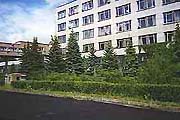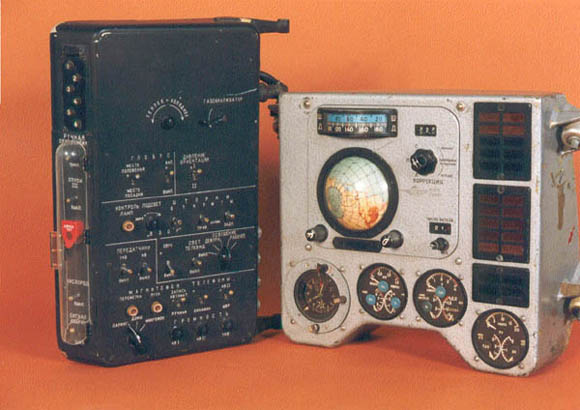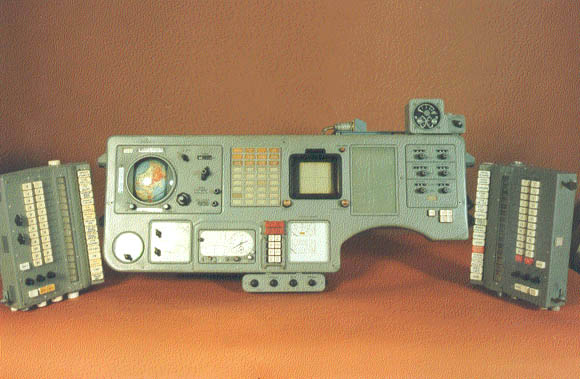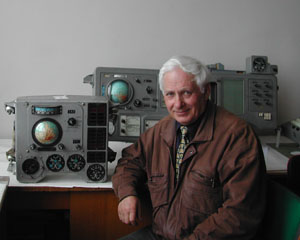|
 The
Specialized Experimental Design Bureau of Spacecraft Technology (SOKB
KT)
is the leading organization in the field of design,
implementation, and support of the following crucial components of
spacecraft technology: The
Specialized Experimental Design Bureau of Spacecraft Technology (SOKB
KT)
is the leading organization in the field of design,
implementation, and support of the following crucial components of
spacecraft technology:
- systems and devices for information display and manual control of
spacecraft ("cosmonauts' control panels"); and
- simulators and training stands for crew training and preparation
for space flights.
The history of SOKB KT NIIAO begins in 1957, when Laboratory 47 with
the staff of 30 was formed within a branch of the Flight Research
Institute (LII) of the USSR Ministry of Aviation Industry. This
laboratory was headed by Sergei Grigor'evich Darevskii, Ph.D. in
engineering, an energetic and competent specialist. In this branch of
industry, this laboratory was one of the leading organizations in the
field of aviation ergonomics. This laboratory designed instrument boards
for various types of aircraft, put forward proposals for representing
flight parameters on multi-function CRT indicators, and developed the
concept of a unified instrument panel for an interceptor. Engineers of
Laboratory 47 were particularly interested in the design of the piloted
spacecraft Vostok developed under the guidance of Sergei Pavlovich
Korolev. One of the most complex problems facing the designers of the spacecraft was the creation of a control system. Among the most
important components of this system was a complex of devices for manual
control and means of displaying information about the condition of all
onboard systems that was necessary for making control decisions. In
early 1960 Korolev asked Darevskii's laboratory to design this complex, since
they had already had some experience with this type of systems. Less
than a year remained before the first manned flight. Despite facing this tight
deadline, laboratory specialists took on this project with
great enthusiasm. The young engineers E.N. Nosov, S.T. Marchenko, G.S.
Makarov, and D.N. Lavrov played a leading role in this project. A
decision was made to design a unified indicator complex that would
include a set of multi-arrow indicators, a re-entry regime control device
(combined with a clock), an indicator of the current location and the
projected landing location (the Globe), and so on. The instrument
board consisted of a single unit connected to the control system and to
the telemetry system. The control panel was designed in a similar way.
The control panel and the board with temperature and pressure indicators
were connected to each other and comprised a system called "the
Cosmonaut's panel," or SIS-1-3KA. 
Control panel and instrument board on the Vostok spacecraft:
Compare to the Mercury instrument
panel The
construction of a unified instrument board and control panel complex
facilitated a rational layout of various onboard systems. This approach
was upheld in subsequent designs and is still used today. The SIS-1-3KA
passed all tests and operated flawlessly during Yurii Gagarin's flight. The
group that worked on the design of the cosmonaut's panel included V.N.
Maksimova, V.N. El'ksnin, G.N. Otreshko, Yu.T. Dragun, A.A. Kirillov,
E.A.
Vaskevich (the customer's representative), the designers V.I. Averin,
E.S. Salfetkin, L.P. Simonenkova, and E.E. Tsypin, the manufacturing
specialists N.Ya. Tsivlin, A.A. Kokorev, V.F. Isaev, V.A. Meleshkin, V.A.
Filippov, N.I. Lizakov, N.V. Kruglikov, V.A. Mosiagin, I.A. Kisliakov,
and others. Space design projects had significant support of the
leadership of the the Flight Research
Institute - its director N.S. Stroev, the chief engineer S.I. Znamenskii,
the LII branch chief engineer V.N. Suchkov. This project became the
foundation of SOKB KT and opened prospects for expansion of its activity
and personnel growth. 
Information display system for the Soyuz-7K and the Soyuz-A8
(the Soyuz-Apollo program) On August 21, 1967, the Specialized Experimental Design Bureau of Spacecraft Technology
was formed within the Flight Research
Institute by a joint decree of the Central Committee of the Communist
Party and the USSR Council of Ministers. The Bureau was assigned the
role of the lead organization for the design of information display
systems for piloted spacecraft. In 1971 the Bureau split off from the
Institute and became an separate organization. At that time the Bureau
was also assigned the role of the lead organization for the design of
complex simulators for cosmonaut training. The Bureau was located in the
town of Zhukovskii near Moscow on a territory adjacent to the Institute.
In that period major Bureau facilities were constructed, such as
engineering and production buildings, a vibration testing pavilion, a
microelectronics equipment production facility, and an entrance
checkpoint. In 1983 the Bureau merged with the Scientific Research Institute of Aviation Equipment
(NIIAO). In 1997 the Bureau was reestablished again as a division within
NIIAO. The new Specialized Experimental Design Bureau of Spacecraft Technology
was formed on the basis of the Institute's Departments 1, 2, and 11, and
groups from the experimental production facility and from the department
of Chief Technician of the Aerospace Division. The
high quality of design and manufacturing, the timely completion of
projects, and the good technical support of its products (including
service on the Baikonur cosmodrome) ensured the leading role of SOKB KT
in the construction of onboard control panels for all Russian piloted
spacecraft. From 1960 to 1999, SOKB KT has developed five generations of information display
systems (IDS) and manual control systems - over 50 types and
modifications of panels in total:
| No. |
Space ship or space station |
IDS name and generation |
IDS components and special features;
distinguishing characteristics of IDS
generations |
| 1 |
2 |
3 |
4 |
| 1 |
Vostok 1 (3KA) |
SIS-1-3KA
|
Aircraft-type control panel and instrument board; orientation
hand controller; lights; pressure, air temperature, and
liquid temperature gauges; a combined display of temporal parameters and
re-entry regimes;
a combined display of the current location and the landing
location; an encoded lock. The equipment is capable of working
in a vacuum. |
| 2 |
Vostok 2 (3KA) |
SIS-2-3KA |
Same, except that the encoded lock for orientation
system was dismantled. |
| 3 |
Voskhod 1 (3KV) |
SIS-3-3KV |
Same for three cosmonauts |
| 4
|
Voskhod 2 (3KD) |
SIS-4-3KD |
Same for two cosmonauts. |
| STVOR |
Controls for various systems and
devices that provide the means for a cosmonaut to leave the
landing module
and the lock chamber. The equipment is capable of working
in a vacuum. |
| 5 |
3KV no. 5 (artificial gravity
spacecraft; never launched) |
SIS-5-3KV
|
The instrument board has a new
design, but in function it is similar to that on board the Vostok and Voskhod
spacecraft.
For the first time the design of the control panel implements
the matrix method of control object selection (the
"command-signal field"), which uses
command-information compression of the first type. For the first
time an electroluminescent display is used in the command-signal
field, and a new type of navigation display is used. Push-button
controls are introduced. The equipment is capable of working in
a vacuum.
|
| 6 |
MARS (heavy-lift interplanetary space
ship) mock-up |
Zvezda |
For the first time experimental or
prototype models of a plasma display, a voice information
system, and other devices were developed. New directions for further IDS
development are set. |
| 7 |
NEK |
Ekran |
Central and peripheral control
stations. The panels implement solutions developed for the
Zvezda IDS. This system is designed as part of the automated
control system for a complex object. |
| 8 |
Soyuz-7k (11F615) |
Sirius-7k
|
Instrument board; command-signal
device, which uses
command-information compression of the second type; finger
controls for orientation and approach type; landing module and
crew compartment lights; air temperature and
liquid temperature gauges; control panel for the utility module;
CRT television-type device for video monitoring, which combines
TV and measurement analog information; laying-in bar indicator;
autonomous multi-mode program control indicator for approach and
re-entry; electroluminescent display. The equipment is capable of
working in a vacuum. |
| 9 |
Zond (L1) (11F91) orbited the Moon |
Saturn |
Landing module control panel with two
command-signal fields (with an uncompressed information signal
field); CRT television-type device for video monitoring;
connection with an onboard computer. The equipment is capable of
working in a vacuum. |
| 10 |
N1-L3 (11F93) intended
for a flight to the Moon and lunar landing |
Uran
|
Return module control panel with two
command-signal fields with digital control and a dark screen
mode; CRT television-type device for video monitoring. The
equipment is capable of working in a vacuum. |
| Orion
|
Approach control panel, which uses
unique two-dimensional devices with light reading and an
original solution for backing up the displayed information on
the panel. |
| Luch
|
Lunar module control panel. The
equipment is capable of working in a vacuum. |
| 11 |
Soyuz-A8 (11F615) |
Sirius-A8 |
Modified version of Sirius-7k. The
equipment is capable of working in a vacuum. |
| 12 |
Soyuz-Apollo |
Sirius-M |
Modified version of Sirius-A8. |
| 13 |
Long-term Orbital Station
(DOS) 17K (Salyut-1, -4, -6, -7) |
Sirius-17K |
Modified version of Sirius-A8. |
| POV |
EVA control panel |
| Mirzam-17K (on Salyut-7) |
PODU-1 and PODU-2: control panels for
the fueling of the unified propulsion system (ODU). For the
first time, light-emitting diodes, a symbolic circuit, a remote
keyboard for command entry, and indicators with light reading
were used. |
| 14 |
Almaz (11F71), the
Orbital Piloted Station (OPS) (Salyut-2, -3, -5) |
Mars
|
IDS for the base unit of the Almaz
complex. For the first time, multiscale gas-discharge indicators
are used. |
| BIPS
|
Optical electronic information
retrieval system |
| DISK-1A
|
Display complex |
| 15 |
Transport supply ship (TKS) for the
Almaz complex (11F72) |
Iupiter |
IDS for the cargo compartment. PGO-1
and PGO-2 panels. Telescopic hand controls. |
| Return module (VA) of the Almaz
complex (11F73) |
Ikar |
IDs for the return module. PVA-1 and
PVA-2. The equipment is capable of
working in a vacuum. |
| 16
|
Long-term Orbital Station
MIR (the base unit) |
Pluton |
Equipment Regime Control Panel and
Emergency Warning Signal Panel with a "dark screen"
mode and a real-time mode. Command Enter Panel with a
hierarchical selection of objects and an optimal display.
Devices with light reading. |
| Mirzam-1A |
Control panels for
the fueling of the unified propulsion system. Mnemonic scheme; light-emitting
diodes; addressed control; remote keyboard for command
entry |
| POV |
EVA control panel |
| Simvol |
Display complex for information
exchange with the onboard computer that serves the guidance and
navigation control system. IDS of the 4th generation. Designed
by VNIIR (the Research and Production Association Fazotron) |
| Stek |
Information and control complex,
which for the first time uses matrix gas-discharge panels. IDS
of the 4th generation. Designed by the Research and Production
Association ELAS |
| Strela |
Information retrieval system with
gas-discharge indicators. IDS of the 4th generation. Designed by
the Research and Production Association ELAS |
| 17 |
MIR modules: Kvant, Spektr, Priroda,
Kristall |
Merkurii |
Unified panels for controlling
equipment regimes, command entry, parameter monitoring, and
emergency warning signaling |
| 18 |
Soyuz-T |
Neptun |
Re-entry module control panel. Return
to the command-signal control field design of the panel. A panel
for information
exchange with the onboard computer. The equipment is capable of
working in a vacuum. |
| Simvol |
Display system for cosmonauts'
interaction with the onboard computer that serves the guidance and
navigation control system. IDS of the 4th generation. Designed
by VNIIR. |
| 19 |
Soyuz-TM |
Neptun-M |
Neptun IDS with an electronic laying-in bar
indicator |
| Simvol |
Display system. Designed by VNIIR. |
| 20 |
Prototype of the Reusable Spacecraft Buran |
Vega-1-GLI |
IDS for the commander and the pilot
(workstations 1 and 2).
Piloting and navigational indicators of aviation type, linked to
an onboard computer. Multi-functional CRT indicators. Digital
devices for altitude and speed parameters. The equipment is
capable of working in a vacuum. |
| BTS-002 |
Adonis |
Display system Adonis (4th generation
IDS) was developed by the Research and Production Association
Elektroavtomatika in Leningrad. |
| Vega-2-GLI |
IDS for the onboard engineer
(workstation 3). |
| 21 |
LL-1 and LL-2 (Tu-154 "flying
lab" aircraft) |
Vega-LL |
IDS for the pilot (workstation 2) in
the cockpit; IDS for workstations 1, 2, and 3 in the passenger
compartment. |
| 22 |
Reusable Spacecraft Buran
(OK-1, 2, 3) |
Vega-1 |
IDS for the commander and the pilot
(workstations 1 and 2). A unified display system functions as
the main instrument for spacecraft guidance and control of
onboard systems. Screen pictures are controlled by a central
computer. |
| Adonis |
Piloting and navigational information
display system for the crew (workstations 1 and 2). 4th
generation IDS. |
| Vega-2 |
IDS for the onboard engineer
(workstation 3). |
| US3-Disk |
Display system that supports
communication between all workstations and the onboard computer.
4th generation IDS. |
| Vega-3 |
IDS for rendezvous operator
(workstation 3). |
| Vega-4 |
IDS for manipulator operator
(workstation 4). |
| Vega-5 |
IDS for payload operator (workstation
5). |
| PShK |
Lock-chamber control panel |
| PSM |
Docking module control panel |
| PBO |
Crew compartment control panel |
| 23 |
Soyuz-TMA |
Neptun-ME
|
Landing module control panel. An
integrated IDS with two screens and three computer processors.
The IDS includes a separate computer system for human-machine
dialogue. |
| Simvol |
Display system. Designed by VNIIR. |
| International Space
Station Alpha |
InPU |
Integrated control panel based on a
VGA monitor and a VS Micro PC of the IBM PC type. 5th generation
IDS for human-machine dialogue. |
| PSS |
Control panel for the emergency
warning signal system in the Zvezda and Zarya modules |
| POV |
Control panel for exiting the docking
module |
|



